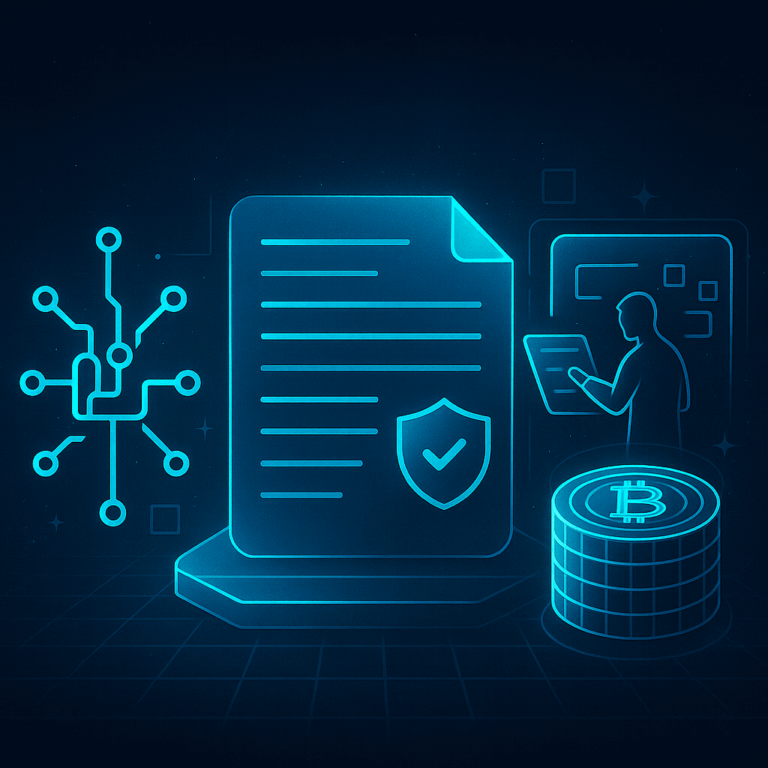
our blogs
What is Smart Contract ?

What is a Smart Contract? The Backbone of Blockchain Innovation
Introduction: Why Smart Contracts Matter in Blockchain
Smart contracts are transforming how blockchain applications work and are now a key part of decentralized systems as blockchain technology continues to grow rapidly. Smart contracts are what make everything work on Web3 — while blockchains serve as the infrastructure. But what exactly is a smart contract, how does it work, and why is it changing industries beyond cryptocurrency? For more Web3 solutions, you can visit UNCW3B.
In this guide, we’ll go into detail about:
- The definition of smart contracts
- Their history and evolution
- How they work in practice
- The contract lifecycle
- Key benefits and limitations
- Real-world use cases
- The future of smart contracts in Web3
What is a Smart Contract? Definition and Examples
A smart contract is a program that runs on its own and is stored on a blockchain. There is no need for middlemen because it automatically enforces the terms of an agreement when certain conditions are met. In this guide, we’ll go into detail about smart contracts, their history, and how smart contracts are used in Web3 today.
It is like a digital version of a regular contract. Not lawyers or banks, but the blockchain network itself makes sure the contract is followed.
Learn more about smart contracts on the Ethereum.org Smart Contracts Guide: Smart Contract A smart contract can be programmed to release payment once goods have been delivered.
- In DeFi platforms, it can automatically execute trades or distribute rewards without human intervention.
A Brief History of Smart Contracts
1994 – Nick Szabo’s Vision
Nick Szabo, a computer scientist, was the first person to use the term “smart contract.” He thought that in the future, people would be able to write contracts directly into computer code and have them carried out without any human help.
2009 – Bitcoin and Programmable Money
Bitcoin didn’t bring about full-blown smart contracts, but it did start the process. Bitcoin showed the world that money could be programmed with its simple scripting language.
2015 – Ethereum Changes Everything
Szabo’s idea became real thanks to Ethereum. When Ethereum came out, developers could use a new programming language called Solidity to write complicated, automated contracts. This was the real start of smart contracts as we know them.
2017–2020 – ICOs and DeFi Growth
Smart contracts powering fundraising and decentralized finance.
2021–2023 – NFTs and DAOs
The rise of creator royalties and decentralized governance.
Today – Expanding Beyond Crypto
Use in industries like healthcare, real estate, and logistics.
How Do Smart Contracts Work? A Step-by-Step Guide
- Code Deployment
Developers write contracts in Solidity, Rust, or Move. - Defining Conditions
“If payment is received, then transfer ownership.” - Automatic Execution
The contract runs as soon as rules are met. - Immutability
Once deployed, the code can’t be changed. - Verification
The blockchain validates every transaction.
The Lifecycle of a Smart Contract
Developers and businesses need to know about the lifecycle of smart contracts:
- Design and Development: A blockchain-specific language is used to write rules, logic, and conditions.
- Testing: Contracts are put on a testnet to see if there are any bugs or security holes.
- Deployment: The contract is put on the mainnet when it is ready.
- Execution: Users interact with the contract via blockchain wallets or applications.
- Termination or Upgrade: Some contracts have built-in conditions for expiration or may interact with upgradeable proxies to allow improvements.
This structured process ensures contracts are reliable, secure, and maintainable.
Popular Smart Contract Platforms
- Ethereum – The pioneer with Solidity.
- BNB Chain – Lower fees and Ethereum compatibility.
- Solana – Fast Rust-based contracts.
- Cardano – Secure contracts with Haskell and Plutus.
- Polkadot & Cosmos – Focused on cross-chain interoperability.
Different ecosystems balance speed, cost, and security in different ways, so developers have choices based on what their project needs.
Smart Contracts vs Traditional Contracts
| Feature | Traditional Contract | Smart Contract |
|---|---|---|
| Enforcement | Lawyers, courts, institutions | Blockchain code and consensus |
| Speed | Days or weeks | Seconds or minutes |
| Cost | High legal/administrative fees | Minimal transaction fees |
| Transparency | Limited | Fully transparent |
| Flexibility | Can be renegotiated | Immutable once deployed |
Benefits of Smart Contracts
- Efficiency: Automating tasks makes them go faster.
- Trustless: The people involved don’t have to trust each other; they just have to trust the code.
- Accuracy: Coding conditions makes it less likely that mistakes will happen.
- Global Accessibility: Anyone with an internet connection can talk to them.
- Innovation: Smart contracts let us make new types of money like DAOs, NFTs, and DeFi.
Limitations and Challenges of Smart Contracts
- Code Vulnerabilities: Bugs can lead to exploits and massive financial losses.
- Immutability Issues: Mistakes in code are permanent unless a hard fork occurs.
- Scalability Problems: High demand on networks like Ethereum leads to high gas fees.
- Regulatory Uncertainty: Legal recognition of smart contracts varies across countries.
- Complexity: Writing secure and efficient contracts requires advanced programming skills.
Real-World Examples of Smart Contracts
- DeFi Lending: A user puts cryptocurrency into Aave. The smart contract automatically gives it to people who need it and pays them interest.
- NFT Royalties: Artists on OpenSea can set up contracts that pay them a percentage of the sale price each time their art is sold.
- Insurance: If a flight is late by more than three hours, the contract pays out right away.
- Supply Chain Tracking: Each step in the logistics process is written down on the blockchain, which makes people more accountable.
These examples show how smart contracts can help in areas that usually depend on trust, paperwork, and middlemen.
The Future of Smart Contracts in Web3
- Layer-2 Solutions: Lower the cost of transactions and make them easier to scale.
- Cross-Chain Contracts: Cross-Chain Contracts: Smart contracts that can be used on more than one blockchain. These smart contracts enhance interoperability and scalability across different Web3 platforms.
- AI Integration: This means using AI and smart contracts together to make decisions that can change and adapt.
- Adoption by Businesses: Banks, governments, and big companies are all looking into smart contracts to save time and money.
- Legal Frameworks: Countries will pass laws that make blockchain-based contracts legal.
Smart contracts will eventually run a lot of the decentralised internet, including finance, healthcare, gaming, and government.
Conclusion: Why Smart Contracts Are the Foundation of Web3
“Smart contracts are essential in Web3 ecosystems.”
are really the engine behind the blockchain revolution. By automating agreements, they cut out the middlemen, reduce costs, and make everything more transparent. Of course, there are still hurdles—scalability, security, and legal clarity—but the potential is massive.
From DeFi and NFTs to healthcare and real estate, smart contracts are changing the way we think about trust and agreements. In my opinion, they’re no longer just a “feature” of blockchain technology—they’ve become the foundation on which Web3 is being built.

